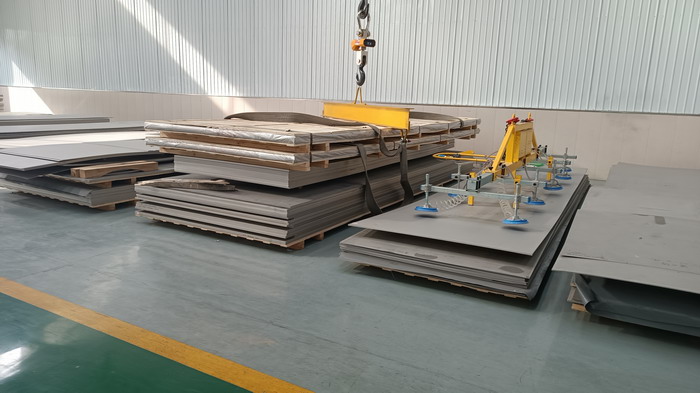Gr5 titanium alloy plate, Gr2 pure titanium plate cutting common process flow
—— Crafting Precision: Common Process Flow for Cutting Gr5 Titanium Alloy Plates and Gr2 Pure Titanium
[ 信息发布:本站 | 时间:2022-10-27 | 浏览:1636 ]

Grade5 titanium plate, titanium alloy plate cutting, the common process flow and content are described as follows:
(1) If it is semi-automatic cutting, then the guide rail should be placed on the plane of the titanium plate, and then the cutting machine is placed on the guide rail, noting that the order cannot be reversed.
(2) The cutting parameters should be appropriate, and should be reasonably determined according to the thickness of the titanium plate, so that a good cutting effect can be obtained.
(3) The cutting gas should be checked whether it is smooth, and if there is blockage, it should be dredged in time.
(4) Before cutting the titanium plate, the surface should be cleaned, and a certain space should be left, which can be conducive to blowing out the slag.
(5) The distance between the cutting nozzle and the surface of the titanium plate should be appropriate, too close and too far is not good.
(6) The preheating of the titanium plate should be sufficient so as not to affect the cutting process.
(7) If the workpiece of different sizes is cut, then the small part should be cut first, and then the large part.
Titanium plate manufacturers show that titanium is a new type of metal, titanium performance and the content of impurities such as carbon, nitrogen, hydrogen, oxygen, the purest titanium iodide impurity content is not more than 0.1%, but its low strength, high plasticity. The properties of 99.5% industrial pure titanium are: density ρ=4.5g/cm3, melting point 1725℃, thermal conductivity λ=15.24W/(m.K), tensile strength σb=539MPa, elongation δ= 25%, section shrinkage ψ= 25%, elastic modulus E=1.078×105MPa, hardness HB195.
(1) High specific strength
The density of titanium alloy is generally about 4.5g/cm3, only 60% of steel, the strength of pure titanium is close to the strength of ordinary steel, and some high-strength titanium alloys exceed the strength of many alloy structural steel. Therefore, the specific strength (strength/density) of titanium alloy is much higher than that of other metal structural materials, as shown in Table 7-1, and components with high unit strength, good rigidity and light weight can be produced. At present, titanium alloys are used in aircraft engine components, skeletons, skins, fasteners and landing gear.
(2) High heat intensity
The use temperature is several hundred degrees higher than that of aluminum alloy, can still maintain the required strength at medium temperature, can work for a long time at 450 ~ 500 ° C temperature These two types of titanium alloys still have a high specific strength in the range of 150 ~ 500 ° C, and the specific strength of aluminum alloy at 150 ° C decreased significantly. The operating temperature of titanium alloy can reach 500℃, and that of aluminum alloy is below 200℃.
(3) Good corrosion resistance
Titanium alloy works in humid atmosphere and seawater medium, its corrosion resistance is much better than stainless steel; Resistance to pitting corrosion, acid corrosion, stress corrosion is particularly strong; Excellent corrosion resistance to alkali, chloride, chlorine, nitric acid, sulfuric acid, etc. However, titanium has poor corrosion resistance to reducing oxygen and chromium salt media.
(4) Good low temperature performance
Titanium alloy can still maintain its mechanical properties at low and ultra-low temperatures. Titanium alloys with good low temperature performance and very low gap elements, such as TA7, can maintain a certain plasticity at -253 ° C. Therefore, titanium alloy is also an important low-temperature structural material.
(5) Large chemical activity
Titanium has a large chemical activity and produces a strong chemical reaction with O, N, H, CO, CO2, water vapor, ammonia and so on in the atmosphere. When the carbon content is greater than 0.2%, hard TiC will be formed in titanium alloy; When the temperature is higher, TiN hard surface will be formed by the interaction with N. Above 600℃, titanium absorbs oxygen to form a hardened layer with high hardness; The embrittlement layer is also formed when the hydrogen content increases. The depth of the hard and brittle surface produced by the absorption of gas can reach 0.1 ~ 0.15mm, and the hardening degree is 20% ~ 30%. The chemical affinity of titanium is also large, and it is easy to adhere to the friction surface.
(6) Small thermal conductivity, small elastic modulus
The thermal conductivity of titanium λ=15.24W/ (m.K) is about 1/4 of nickel, 1/5 of iron, 1/14 of aluminum, and the thermal conductivity of various titanium alloys is about 50% lower than the thermal conductivity of titanium. The elastic modulus of titanium alloy is about 1/2 of steel, so its rigidity is poor, easy to deform, it is not suitable to make slender rods and thin-walled parts, and the amount of rebound of the machining surface during cutting is very large, about 2 to 3 times that of stainless steel, resulting in severe friction, adhesion and adhesive wear of the tool after the tool surface.
Ms. Vivian
Shaanxi Qianyi Tuoda Technology Co., Ltd
Email:qy002@sxqytd.com
Website:www.sxqytd.com
Titanium Alloy Rods, Titanium Alloy Sheets, Titanium Alloy Tubes, Titanium Alloy Fasteners, Titanium Alloy Forgings, Titanium Alloy Wire, Titanium Alloy Bars, Titanium Alloy Plates, Titanium Alloy Pipe Fittings, Titanium Alloy Springs, Titanium Alloy Bolts, Titanium Alloy Nuts, Titanium Alloy Screws, Titanium Alloy Washers, Titanium Alloy Flanges
